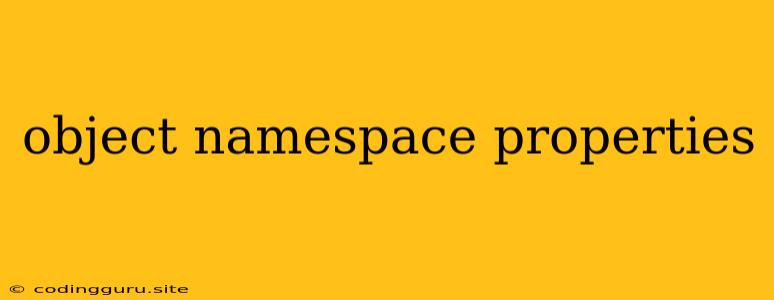Understanding Object Namespaces and Their Properties
In the realm of programming, objects are fundamental building blocks that encapsulate data and behavior. Namespaces, on the other hand, provide a structured way to organize and manage these objects. This article delves into the concept of object namespaces and explores how they interact with properties to create a robust and maintainable codebase.
What is an Object Namespace?
Imagine a large city with numerous buildings. Each building represents an object containing its own unique features and functions. To keep things organized, the city might be divided into different districts, each with its own set of rules and characteristics. Namespaces act like these districts, providing a logical grouping for related objects.
Think of a namespace as a container or a container of containers for your objects. This container helps you avoid naming conflicts and makes your code more modular and maintainable. For example, in JavaScript, you might use namespaces to separate your application's UI components from its business logic:
// Namespace for UI components
const UI = {
Button: function(label) {
// ... implementation of a button component
},
Input: function(type) {
// ... implementation of an input component
}
};
// Namespace for business logic
const BusinessLogic = {
calculateTotal: function(items) {
// ... implementation of a function to calculate total cost
}
};
Properties and Namespaces: A Close Relationship
Within a namespace, objects can possess various properties. These properties represent attributes, characteristics, or data associated with the object. Consider the example of a "Car" object residing in a "Vehicles" namespace:
// Namespace for vehicles
const Vehicles = {
Car: {
brand: "Toyota",
model: "Camry",
year: 2023,
color: "Silver"
}
};
Here, the Car object within the Vehicles namespace has properties like brand, model, year, and color. These properties define the specific characteristics of this particular car object.
Accessing Properties within Namespaces
To access a property of an object residing within a namespace, you use a hierarchical approach. For instance, to retrieve the model of the Car object within the Vehicles namespace, you would use:
const carModel = Vehicles.Car.model;
console.log(carModel); // Output: Camry
This demonstrates how namespaces act as containers, providing a clear path to access the properties of individual objects within them.
Benefits of Using Namespaces
Using namespaces offers several advantages:
- Organization and Modularity: Namespaces help structure your code, making it easier to manage and understand.
- Collision Avoidance: They prevent naming conflicts, especially in large projects with multiple developers.
- Code Reusability: Namespaces enable the creation of reusable code libraries.
- Improved Maintainability: Changes within a namespace are contained, reducing the risk of unintended consequences in other parts of your code.
Namespaces in Different Languages
While the concept of namespaces is common in many programming languages, the specific syntax and implementation might vary.
- JavaScript: Namespaces in JavaScript are typically implemented using objects, as shown in the previous examples.
- Python: Python uses modules and packages to achieve a similar effect as namespaces.
- Java: Java provides the
packagekeyword to define namespaces. - C++: C++ utilizes the
namespacekeyword for organizing code.
Conclusion
Object namespaces are essential tools for structuring and organizing your code. They allow you to group related objects and their properties logically, creating a more maintainable and scalable codebase. Understanding the concept of namespaces and their interaction with object properties empowers developers to write cleaner, more organized, and less error-prone code. By embracing namespaces, you can build robust and scalable applications that are easier to maintain and extend over time.
